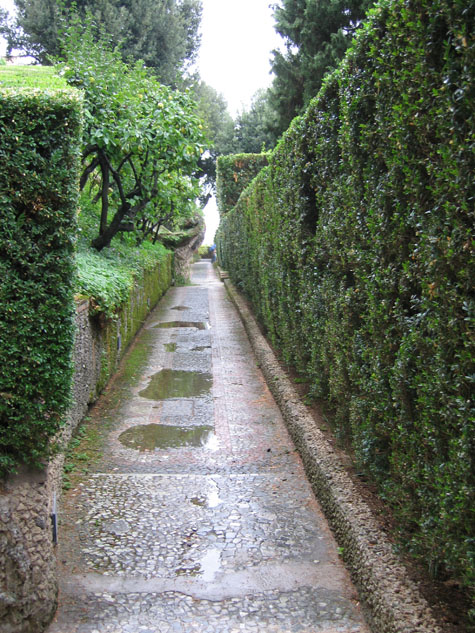 The effect of wind on a garden is easy to write about, but incredibly difficult to physically document. I had my chance. Wind is an invisible force that influences hardiness. Wind can take down ancient trees, burn boxwood, rhododendron and other broad leaved evergreens. Persistant wind can change the shape of the trunks of trees. Wind is a dessicant-dessication over a winter can damage and kill. Our winter storm of the past few days is child’s play compared to what people in the Plains, and Chicago endured, but there were lessons in our town. The wind yesterday was visible-thanks to a steady snowfall. Neither of the Corgis wanted to go outside, unless I went with them. As bundled up as I was, the fierce winds took me aback. The blowing snow stung my face but good.
The effect of wind on a garden is easy to write about, but incredibly difficult to physically document. I had my chance. Wind is an invisible force that influences hardiness. Wind can take down ancient trees, burn boxwood, rhododendron and other broad leaved evergreens. Persistant wind can change the shape of the trunks of trees. Wind is a dessicant-dessication over a winter can damage and kill. Our winter storm of the past few days is child’s play compared to what people in the Plains, and Chicago endured, but there were lessons in our town. The wind yesterday was visible-thanks to a steady snowfall. Neither of the Corgis wanted to go outside, unless I went with them. As bundled up as I was, the fierce winds took me aback. The blowing snow stung my face but good.
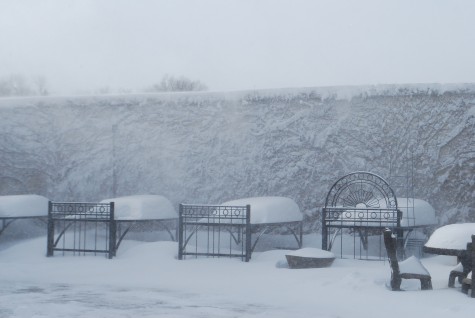
The shop property is a walled property. The mini-storage complex that surrounds us on 3 sides created a walled garden. The walls of their storage units are concrete block-and very tall. I have covered most of these walls with Boston Ivy-parthenocissus tricuspidata “Veitchii”. The wall is beautiful in summer and fall. Yesterday, a winter incarnation I had never seen before.
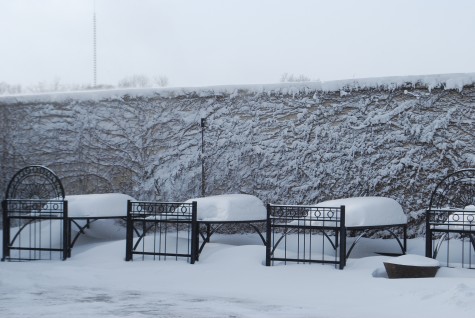 Gusting winds blew the snow straight sideways. Every branch had a snow load. The texture and color of this wall-pretty gorgeous. The wind was biting. The snow on my plant tables eloquently speak to windbreaks. I am sure you have seen pictures, or visited farms whose fields were enclosed by evergreens. Those work horses of northern gardens-windbreaks mitigate the effect of the wind. The snow close to the wall-undisturbed.
Gusting winds blew the snow straight sideways. Every branch had a snow load. The texture and color of this wall-pretty gorgeous. The wind was biting. The snow on my plant tables eloquently speak to windbreaks. I am sure you have seen pictures, or visited farms whose fields were enclosed by evergreens. Those work horses of northern gardens-windbreaks mitigate the effect of the wind. The snow close to the wall-undisturbed.
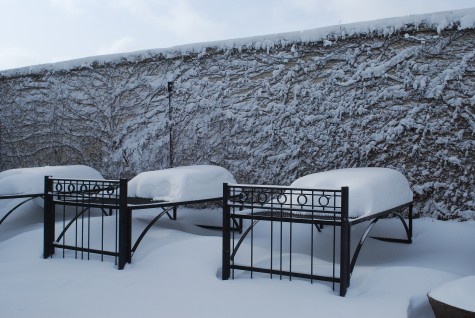 Out of the protective range of this wall, every shred of snow was blown off these tables. Translate this to the plants you have in the ground. I have my vain moments. I plant marginally hardy plants-hoping for a good outcome. Hardiness-what does this mean? A good bit of hardiness in my zone depends of good drainage. Given that most of the soil I plant in is heavy clay, this precludes lavender, and Japanese iris. Lest you protest, Japanese Iris flourish in swampy soil during the garden season, but they need a substantial drain away to survive the winter. Lavender-how they thrive in England, and France. In my zone, they hate winter water retentive soil-and wind. Winter winds play havoc with broad leaved evergreens here. I have seen no end of badly burned azaleas and rhododendrons. Wind-is this part of your zone? Plan accordingly. Some marginal plants may be able to thrive, given some protection from winter winds. I have seen Magnolia Grandiflora growing in my zone. They had to have been planted in the most optimal spot. Figuring out the most optimal spot-not always so easy. The plant will tell you sooner or later.
Out of the protective range of this wall, every shred of snow was blown off these tables. Translate this to the plants you have in the ground. I have my vain moments. I plant marginally hardy plants-hoping for a good outcome. Hardiness-what does this mean? A good bit of hardiness in my zone depends of good drainage. Given that most of the soil I plant in is heavy clay, this precludes lavender, and Japanese iris. Lest you protest, Japanese Iris flourish in swampy soil during the garden season, but they need a substantial drain away to survive the winter. Lavender-how they thrive in England, and France. In my zone, they hate winter water retentive soil-and wind. Winter winds play havoc with broad leaved evergreens here. I have seen no end of badly burned azaleas and rhododendrons. Wind-is this part of your zone? Plan accordingly. Some marginal plants may be able to thrive, given some protection from winter winds. I have seen Magnolia Grandiflora growing in my zone. They had to have been planted in the most optimal spot. Figuring out the most optimal spot-not always so easy. The plant will tell you sooner or later.
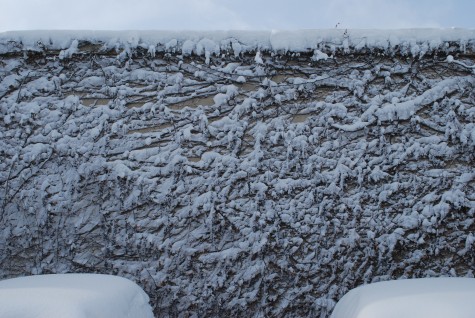 Today, I am somewhat focused on what I cannot have. Noisette roses, for instance. Hedges of rosemary. I am not thinking about other more tropical places, such as the Bahamas, or St. Barts. Just a few plants just barely beyond my grasp. I am looking at what the wind has delivered, and wondering if I will see damage in the spring. The boxwoods are loaded with snow; the wind it moving that weight in such a way that I worry about stem crack. Big winds made for a moment I would do well to observe. Though some weather is impossible to plan for, some thoughtfulness about plant placement can help mitigate what nature dishes out.
Today, I am somewhat focused on what I cannot have. Noisette roses, for instance. Hedges of rosemary. I am not thinking about other more tropical places, such as the Bahamas, or St. Barts. Just a few plants just barely beyond my grasp. I am looking at what the wind has delivered, and wondering if I will see damage in the spring. The boxwoods are loaded with snow; the wind it moving that weight in such a way that I worry about stem crack. Big winds made for a moment I would do well to observe. Though some weather is impossible to plan for, some thoughtfulness about plant placement can help mitigate what nature dishes out.
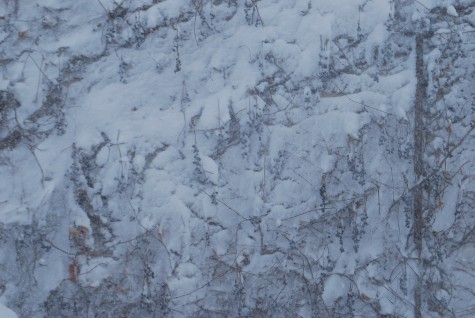 At the height of the wind yesterday-I was out there with my camera. This wall with the skeletal remains of boston ivy vines, and their draping fruits-so beautiful. Blown around, I was. Blown around I am, regularly, by nature.
At the height of the wind yesterday-I was out there with my camera. This wall with the skeletal remains of boston ivy vines, and their draping fruits-so beautiful. Blown around, I was. Blown around I am, regularly, by nature.
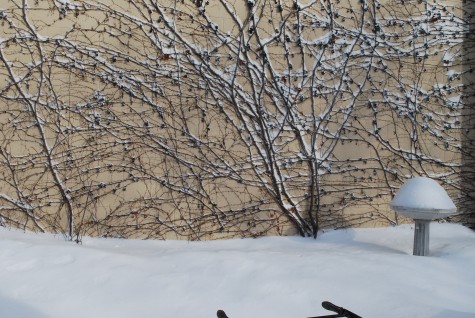 The forceful winds affected every square inch of my life. The roads. The ground plane. The evergreens. The driveway. The streets. The Corgi yard. I am used to winds in the spring, in March. These February winds-unusual. It seems like I see weather regularly that I have never seen before.
The forceful winds affected every square inch of my life. The roads. The ground plane. The evergreens. The driveway. The streets. The Corgi yard. I am used to winds in the spring, in March. These February winds-unusual. It seems like I see weather regularly that I have never seen before.  These drifts-the wind is the engine. Notice how the wind swirled and piled up the snow. I am more than sure should you live almost anywhere in this country right now, you have photos much like like mine. Windswept-we are.
These drifts-the wind is the engine. Notice how the wind swirled and piled up the snow. I am more than sure should you live almost anywhere in this country right now, you have photos much like like mine. Windswept-we are.
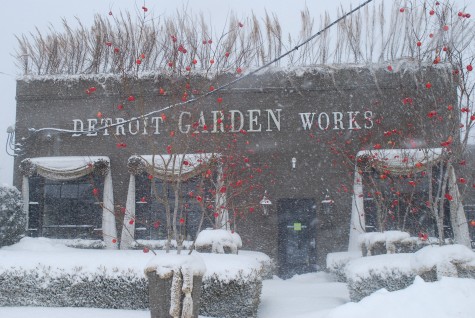
Snowy and windswept-this is where we are at this early February.
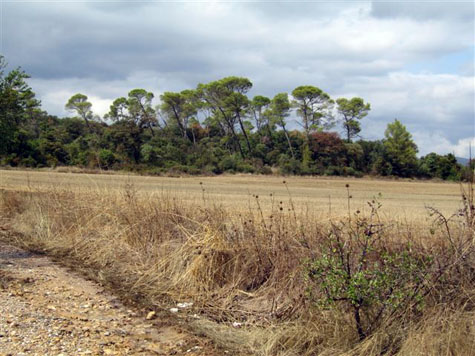 Earth, air, fire and water; the mythology is long and varied. My simple version: the sculpture, which is the earth, makes for life. No less important is air-every living thing breathes.
Earth, air, fire and water; the mythology is long and varied. My simple version: the sculpture, which is the earth, makes for life. No less important is air-every living thing breathes.

